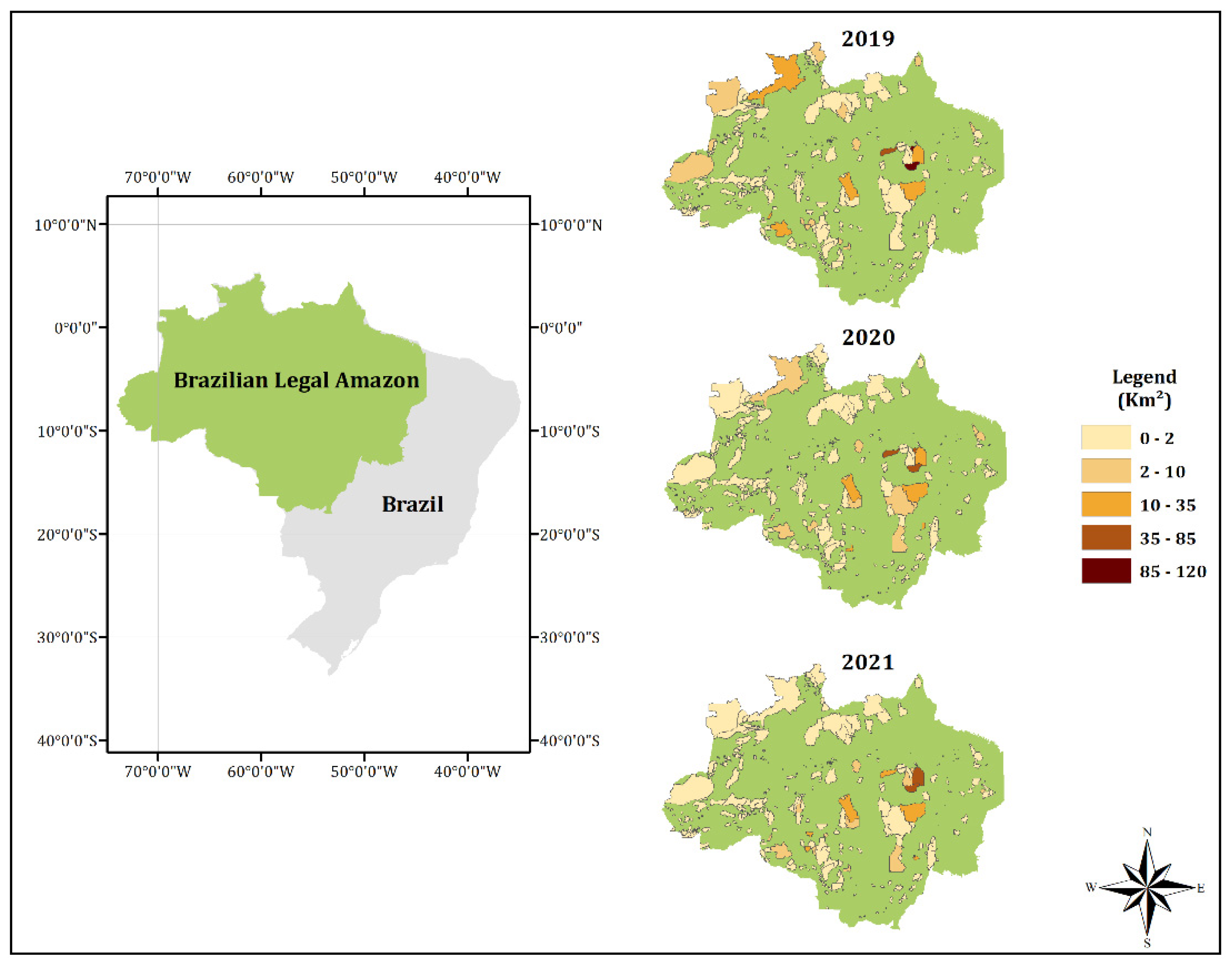Protecting Amazonia Should Focus on Protecting Indigenous, Traditional Peoples and Their Territories
Author Contributions
Funding
Conflicts of Interest
References
- Silva Junior, C.H.L.; Pessoa, A.C.M.; Carvalho, N.S.; Reis, J.B.C.; Anderson, L.O.; Aragao, L. The Brazilian Amazon deforestation rate in 2020 is the greatest of the decade. Nat. Ecol. Evol. 2021, 5, 144–145. [Google Scholar] [CrossRef] [PubMed]
- National Institute for Space Research (INPE). Monitoring of the Brazilian Amazon Deforestation by Satellite. Available online: http://terrabrasilis.dpi.inpe.br/app/dashboard/deforestation/biomes/legal_amazon/rates (accessed on 8 December 2021).
- de Oliveira, G.; Chen, J.M.; Stark, S.C.; Berenguer, E.; Moutinho, P.; Artaxo, P.; Anderson, L.O.; Aragao, L. Smoke pollution’s impacts in Amazonia. Science 2020, 369, 634–635. [Google Scholar] [CrossRef] [PubMed]
- Mataveli, G.A.V.; de Oliveira, G.; Seixas, H.T.; Pereira, G.; Stark, S.C.; Gatti, L.V.; Basso, L.S.; Tejada, G.; Cassol, H.L.G.; Anderson, L.O.; et al. Relationship between Biomass Burning Emissions and Deforestation in Amazonia over the Last Two Decades. Forests 2021, 12, 1217. [Google Scholar] [CrossRef]
- Escobar, H. Brazil’s deforestation is exploding—And 2020 will be worse. Science 2019. [Google Scholar] [CrossRef]
- Villén-Pérez, S.; Anaya-Valenzuela, L.; Conrado da Cruz, D.; Fearnside, P.M. Mining threatens isolated indigenous peoples in the Brazilian Amazon. Glob. Environ. Chang. 2021, 102398, in press. [Google Scholar] [CrossRef]
- Rorato, A.C.; Camara, G.; Escada, M.I.S.; Picoli, M.C.A.; Moreira, T.; Verstegen, J.A. Brazilian amazon indigenous peoples threatened by mining bill. Environ. Res. Lett. 2020, 15, 1040a3. [Google Scholar] [CrossRef]
- Rorato, A.C.; Picoli, M.C.A.; Verstegen, J.A.; Camara, G.; Silva Bezerra, F.G.; Escada, M.I.S. Environmental Threats over Amazonian Indigenous Lands. Land 2021, 10, 267. [Google Scholar] [CrossRef]
- Conceição, K.V.; Chaves, M.E.D.; Picoli, M.C.A.; Sánchez, A.H.; Soares, A.R.; Mataveli, G.A.V.; Silva, D.E.; Costa, J.S.; Camara, G. Government policies endanger the indigenous peoples of the Brazilian Amazon. Land Use Policy 2021, 108, 105663. [Google Scholar] [CrossRef]
- de Oliveira, G.; Chen, J.M.; Mataveli, G.A.V.; Chaves, M.E.D.; Seixas, H.T.; Cardozo, F.d.S.; Shimabukuro, Y.E.; He, L.; Stark, S.C.; dos Santos, C.A.C. Rapid Recent Deforestation Incursion in a Vulnerable Indigenous Land in the Brazilian Amazon and Fire-Driven Emissions of Fine Particulate Aerosol Pollutants. Forests 2020, 11, 829. [Google Scholar] [CrossRef]
- Guerrero, J.V.R.; Escobar-Silva, E.V.; Chaves, M.E.D.; Mataveli, G.A.V.; Bourscheidt, V.; de Oliveira, G.; Picoli, M.C.A.; Shimabukuro, Y.E.; Moschini, L.E. Assessing Land Use and Land Cover Changes in the Direct Influence Zone of the Braço Norte Hydropower Complex, Brazilian Amazonia. Forests 2020, 11, 988. [Google Scholar] [CrossRef]
- Heredia-R, M.; Torres, B.; Cabrera-Torres, F.; Torres, E.; Díaz-Ambrona, C.G.H.; Pappalardo, S.E. Land Use and Land Cover Changes in the Diversity and Life Zone for Uncontacted Indigenous People: Deforestation Hotspots in the Yasuní Biosphere Reserve, Ecuadorian Amazon. Forests 2021, 12, 1539. [Google Scholar] [CrossRef]
- Garnett, S.T.; Burgess, N.D.; Fa, J.E.; Fernández-Llamazares, Á.; Molnár, Z.; Robinson, C.J.; Watson, J.E.M.; Zander, K.K.; Austin, B.; Brondizio, E.S.; et al. A spatial overview of the global importance of Indigenous lands for conservation. Nat. Sustain. 2018, 1, 369–374. [Google Scholar] [CrossRef]
- Urzedo, D.; Chatterjee, P. The Colonial Reproduction of Deforestation in the Brazilian Amazon: Violence against Indigenous Peoples for Land Development. J. Genocide Res. 2021, 23, 302–324. [Google Scholar] [CrossRef]

Publisher’s Note: MDPI stays neutral with regard to jurisdictional claims in published maps and institutional affiliations. |
© 2021 by the authors. Licensee MDPI, Basel, Switzerland. This article is an open access article distributed under the terms and conditions of the Creative Commons Attribution (CC BY) license (https://creativecommons.org/licenses/by/4.0/).
Share and Cite
de Oliveira, G.; Mataveli, G.A.V.; dos Santos, C.A.C.; He, L.; Hellenkamp, S.E.; Funatsu, B.M.; Stark, S.C.; Shimabukuro, Y.E. Protecting Amazonia Should Focus on Protecting Indigenous, Traditional Peoples and Their Territories. Forests 2022, 13, 16. https://doi.org/10.3390/f13010016
de Oliveira G, Mataveli GAV, dos Santos CAC, He L, Hellenkamp SE, Funatsu BM, Stark SC, Shimabukuro YE. Protecting Amazonia Should Focus on Protecting Indigenous, Traditional Peoples and Their Territories. Forests. 2022; 13(1):16. https://doi.org/10.3390/f13010016
Chicago/Turabian Stylede Oliveira, Gabriel, Guilherme A. V. Mataveli, Carlos A. C. dos Santos, Liming He, Skye E. Hellenkamp, Beatriz M. Funatsu, Scott C. Stark, and Yosio E. Shimabukuro. 2022. "Protecting Amazonia Should Focus on Protecting Indigenous, Traditional Peoples and Their Territories" Forests 13, no. 1: 16. https://doi.org/10.3390/f13010016
APA Stylede Oliveira, G., Mataveli, G. A. V., dos Santos, C. A. C., He, L., Hellenkamp, S. E., Funatsu, B. M., Stark, S. C., & Shimabukuro, Y. E. (2022). Protecting Amazonia Should Focus on Protecting Indigenous, Traditional Peoples and Their Territories. Forests, 13(1), 16. https://doi.org/10.3390/f13010016







